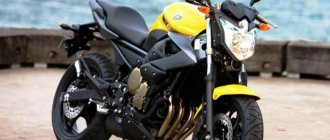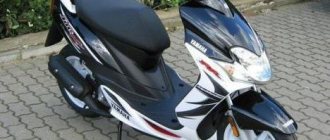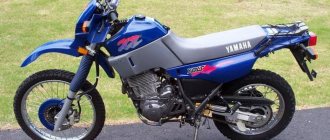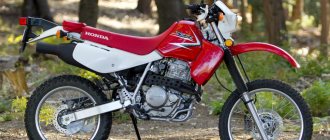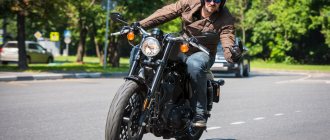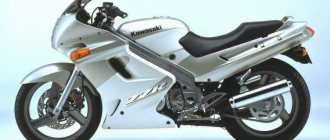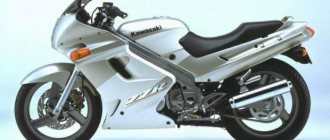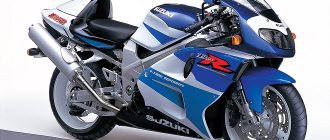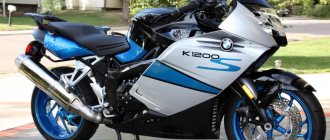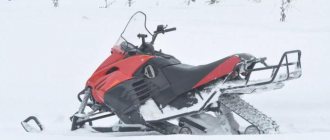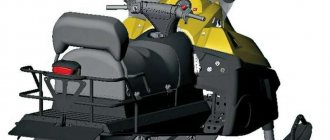This is a fairly typical naked bike, which, however, has earned popularity. An inexperienced motorcyclist may think that the model is not dynamic enough, but it’s all about the speed. At the lower end, the Yamaha FZ6 simply does not show all its abilities, but once you accelerate, the car will reveal its best side.
Of course, not everyone will like this feature, especially if we talk about connoisseurs of low revs. But a reasonable question arises: why would such people buy such a bike if they can buy themselves a good cruiser, either for the city or for the trails outside of it?
Dimensions and weight
Depending on the version, weight may vary slightly. However, the range of change is small and the average curb weight of this model is about 200 kg. However, this is largely due to the spacious tank of 19 liters. Many will consider this to be too high an indicator for such a simple city bike, because it is not at all suitable for spacious country roads. The average saddle height is 795 mm.
Equipment
The Yamaha FZ6 has a very short warm-up period. The technical characteristics, it is worth noting, of this bike are very good. Its fuel-injected engine is very powerful and delivers excellent results. When you turn the key slightly, the electronic instrument unit immediately comes to life, after which the self-testing process begins. It should be noted that the engine itself is not audible at such idle conditions. The seating position is almost straight, exactly like on a universal bike, the most comfortable. Your legs feel like they're a glove - you don't have to look for a footrest.
Chassis and brakes
A characteristic feature of the FZ6 is that the front and rear suspension travel is the same and amounts to 130 mm. This is neither too much nor too little, but considering the class, it’s just right. A pair of brake discs at the front and one at the rear fully provide the model with the necessary braking potential; fortunately, Yamaha did not skimp and install a drum brake in the rear.
Apparently, to facilitate the design, the frame here is made of aluminum. However, the weight of about 200 kg, even with fuel, is a sufficient justification for such measures, because, after all, this is a typical naked bike, and not some kind of sports tourer or hybrid.
Back in the middle of the 2021 season on the xjr400, I realized that it was not enough for me - the maximum speed was around 170+, it was extremely difficult to keep the cruiser at 150+ (namely, this was the speed at which my comrades usually rode along the track on 600s), plus There were some difficulties with overtaking long columns or trucks, because of which I often fell behind “my friends.” And the hijer himself is already noticeably outdated, both morally and physically. I wrote about its main technical shortcomings earlier, but among the moral ones I would classify the boring appearance of a classic road builder.
I came to the choice of the next motorcycle with the following requirements: - volume 600 - 800 cc; — power around 100 hp; — injector; — the most recent year of manufacture (from 2008); - beautiful, not boring, not like a hijer appearance (individual taste, of course); — comfortable fit for long trips (500+ km); — a sport or road worker with dimensions adequate for the city and between rows (I generally like sport tours like the VFR800, but they feel like a clumsy “cow” in traffic jams); — absence of serious “childhood sores” and reliability in operation; — full wind protection (that is, naked bikes are bypassed). Quite a few models fit these requirements, but the main part was quickly eliminated, and in the end I chose between the CBR 600 F4i, FZ6 S2 and XJ6 Diversion.
The CBR 600 F4i is the most comfortable sport (or even sport-touring) with a riding position that doesn't make my injured knee start to ache after half an hour of riding. It is he who leads in terms of comfort in my personal rating of 600 sports (then comes the ZX6R, and the last place is shared by the p6 and the jixer). And since my student years I have dreamed of CBR. In the end, I didn’t buy it - I couldn’t find an option suitable for the price and condition.
So, it’s almost mid-November 2021, all the interesting options in the nearest cities have been examined and I’m mentally prepared for the winter and changing my motorcycle in the spring.
At the same time, my vacation in Crimea was ending and just a couple of hours before departure, almost at night, the option to look at the 2010 FZ6 S2 suddenly appeared. And I really liked it - at first from the outside, and then when I tried to ride it, I realized: this is mine, this is exactly what I was looking for.
At the same time, at the time of inspection of the FZ6, I already had an agreement to watch the sabotage in another city. A very, very tasty diversion - 2011, abs, full plastic body kit, 3 hard cases included... and the price is the same as the FZ6. And yet... She seemed “cotton” to me. It starts, drives, twist the handle - it goes faster. But there is no sense of character. Xjr 400 was more fun, or something. (For comparison, a couple of days later I got my hands on a sabotage naked 2009, and it behaved completely differently - sharp, with a clear pickup at 4000, provoking aggressive driving and very comfortable in the city (especially after the phaser), since the dimensions the diversion is noticeably smaller and does not have a long and heavy plastic muzzle).
In general, on the very first weekend I picked up Phaser and drove him home. Almost 500 km in mid-November, of which 400 km were in continuous rain. On an unfamiliar motorcycle that has almost 2 times more power than my previous one. The trip was fun.
…400 days and 16,000+ km later…
Results and conclusions after the season on FZ6.
The Phaser has fully lived up to its reputation as an inexpensive (to maintain) and versatile motorcycle.
Quite maneuverable in the city and between the rows, quite powerful and responsive on the highway. It has really excellent standard wind protection - at 179 cm tall, I can ride with a completely straight landing even at 160 km/h, the wind does not bother me and does not drown out the music in the headset (and this is in a rather noisy helmet).
The most comfortable cruising speed is 150-160 km/h, in 6th gear this is average speed, 7-8 thousand. The red zone starts at 14,000, the real cutoff is about 14,500, and my maximum 230 km/h was at 12 - 12.5 thousand rpm).
On the highway, the Phaser (specifically the FZ6 S2) is simply very pleasant. I would say that it is intended for the track. At 150 km/h, even in 6th gear, there is enough power to pick up speed normally and not have problems with overtaking.
In the city, 3 gears are enough, 4 is needed if you want to save fuel and drive around 100 km/h at 4-5 thousand rpm. It is especially useful if you have direct flow and do not want to anger residents of residential areas. The stock exhaust is almost silent, but the engine is quite noisy.
Fuel consumption is very dependent on driving style. My record is less than 3.5 liters per 100 km, 6th gear, 110-130 km/h. I had to save money, since there were 68 km to refueling, and the reserve light (3.5 liters) had already come on. At the gas station I then filled up about 17 liters (tank capacity 19.4 liters according to BikesWiki).
On average, I use 1 tank for 250 km in the city in active driving mode.
If you drive along the highway “with all your money”, then at a speed of 170-200 km/h in 200 km the phaser consumed a little more than 15 liters.
The main problem is that it’s really hot on Fazer in the summer. And there are two reasons. In traffic jams, air from the engine goes to the legs, and even the manifold pipe runs directly under the seat, which creates additional heating for the butt. It's nice in cold weather, but definitely not in summer.
A month ago, I finally removed the exhaust and the first part of the “elbow” of the manifold, where the last catalyst is located - the exhaust was gutted, the partitions were removed and refilled, making a direct flow, and the pipe was wrapped in thermal tape, correcting the stupid heating of the ass. By the way, the brake fluid reservoir for the rear circuit is located next to the pipe and is heated by it. Apparently, a small engineering miscalculation, although even at +40 I did not feel that it was starting to overheat and there was no loss of braking quality.
At the beginning of last season (2018), an extraneous metallic sound appeared, which occurred above 6000 rpm and was very similar to the sound of a failed tensioner and a stretched timing chain: the source of the sound was exactly where it was located. Luckily it turned out to be not a chain, but a cage mount (crazy iron).
By the way, this is a kind of “arc/cage disease” on Phasers - due to vibration, the tightening of the bolts and nuts that tighten the cage weakens, strong vibrations appear on the steering wheel when the motorcycle warms up. In my case, the cells also began to ring after 6k revolutions.
It can be treated by periodically tightening the fasteners or using a thread locker (but I don’t recommend using a threadlocker - to change the oil, it’s easier to remove one half of the cage than to try to get to the oil filter).
The front fork is budget, without adjustments - you can adjust it either by changing the oil or replacing the springs. Some people put washers under the stock springs, but I’m not sure that this is a good solution - although they say it works. After half an hour of driving in the city, my arms and shoulders were tired and “clogged”, after which I disassembled the fork and filled in 10w oil (I saw in the manual that “factory oil” has a viscosity of both 5w and 10w, while people sometimes fill in 15w. And at the same time it doesn’t even knock out the seals, although I didn’t risk it). It became much better, even almost optimal. Lacks fine tuning, but oh well. Still not a track car. When I drained the oil from the fork, it seemed to me that it was still there from the factory in Japan - a greenish liquid poured out, which looked more like water than oil. I can say that it was exactly 5w based on my personal feelings about the stiffness of the fork before and after changing the oil.
There have been no serious interventions on the technical side of the motorcycle yet. In theory, I need valve clearances (the mileage is already 64,000, as if it’s time), but for now I still can’t muster up the courage to go to the service - I don’t want to go there myself.
After wintering, the fuses for the turn signal-side marker line suddenly started to burn. I haven't found the reason yet. They burn interestingly - not immediately, but after about 10-15 kilometers. There was a suspicion that after replacing the stock “shovel” with a different license plate mount, the turn signal wires were routed unsuccessfully - this was not confirmed. They also found a poorly insulated piece of wire that could short out when in contact with the frame (from the license plate light, which was completely removed) - this was not confirmed. So let's look further.
PS - Found the reason. And yet these are turn signals: when replacing the wiring, they laid it close to the exhaust, as a result the insulation melted and the wire periodically touched the frame, which burned the fuses.
And since I got to the electrics, at the same time as searching for the source of the short circuit, a high beam headlight was connected to work on the low beam (there are instructions in the phaser club, in fact, just a wire from the “low” headlight is thrown to the empty chip of the “high” headlight. BUT. There is a catch. If just throw in a wire, then 3 threads will light up on the high beam: low-low-high. And this is a crapshoot for the generator and can drain the battery if you drive below 5 thousand rpm for a more or less long time. Fixed with the help of a relay that is embedded in the line ). The second modification to the electrics is that the rear turn signals are connected as dimensions. Since I have diodes and are really bright, we decided the following: the lights are constantly on at about 1/3 of full brightness, and the turn signals work at full brightness. As a result, they “eat” very little, they are almost invisible during the day (although during the day they are not needed anyway, in fact), but at night they are clearly visible. At about 200 meters they are quite distinguishable. This calmed my paranoia that at night the dimensions of a motorcycle were not perceived as a motorcycle, and not a car with one non-functioning dimension.
Cost of owning a phaser per year
Consumables: 3 oil changes with filter ~ 7500 RUR; Air filter - 800 RUR; Antifreeze - 1350 RUR; Brake fluid (for all circuits) - 800 rubles; Changing the oil in the fork - 450 rubles; Front pads - 3200 rub.
Goodies: Stickers for wheels and tank - 1500 rubles; Short levers with ali - 1050 rubles; Frame for a number from Crazy Iron - 1350 RUR; Turn signals (glass donor for the original turn signal) - 600 rubles; Alarm ~13000 RUR; Cage repair - 2000 RUR; Polishing - 5000 rub; Direct flow and thermal tape - 7000 rubles; Electrical improvements - 2000 rub.
And a little more than a ton of burned fuel: motorcycling is, of course, fun, but it’s not cheap.
Below are just a few photos from our trips.
Details
What no vehicle can exist without is wheels. And, accordingly, without tires. They deserve the highest praise for this model - they have excellent grip properties, both on dry and wet asphalt. Another thing to note is the rear tire, which is much wider compared to other models. Due to it, high directional stability is ensured. There are two large, almost 300mm, discs that have twin-piston calipers from Akebono at the front and one at the rear from Nissan. This all indicates increased efficiency. From high speed the motorcycle settles down perfectly, and to add braking force you don’t need much – two fingers are enough. We can say that the motorbike remained almost the same model as the previous one, the one that all motorcyclists are used to seeing. This is a practical bike with a distinctly sporty feel and a slightly aggressive character, but with an undeniably individual look. The entire list of these advantages ends with excellent quality, which, in fact, is fully inherent in all models of this world-famous concern. This motorcycle simply cannot but please true connoisseurs of quality, harmoniously combined with a stylish appearance and excellent technical characteristics. The previous model earned a reputation as just such a motorbike, and in the Yamaha FZ6 all this was confirmed.
